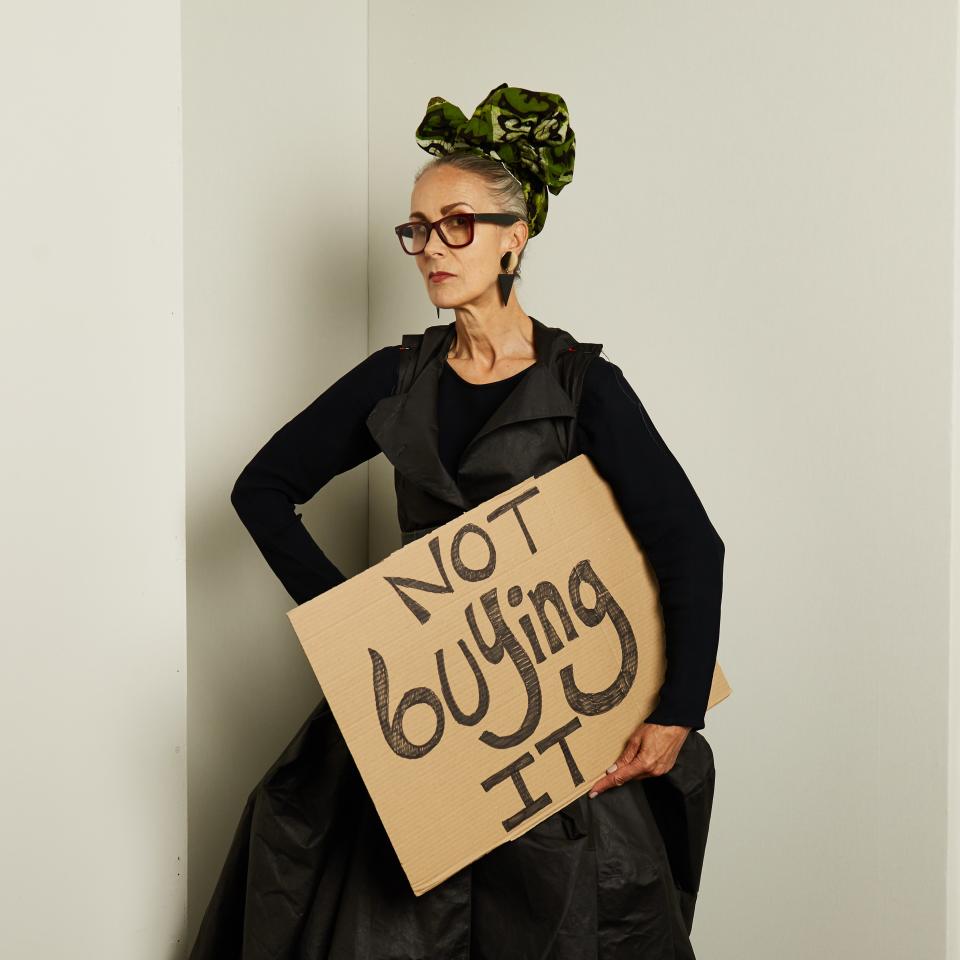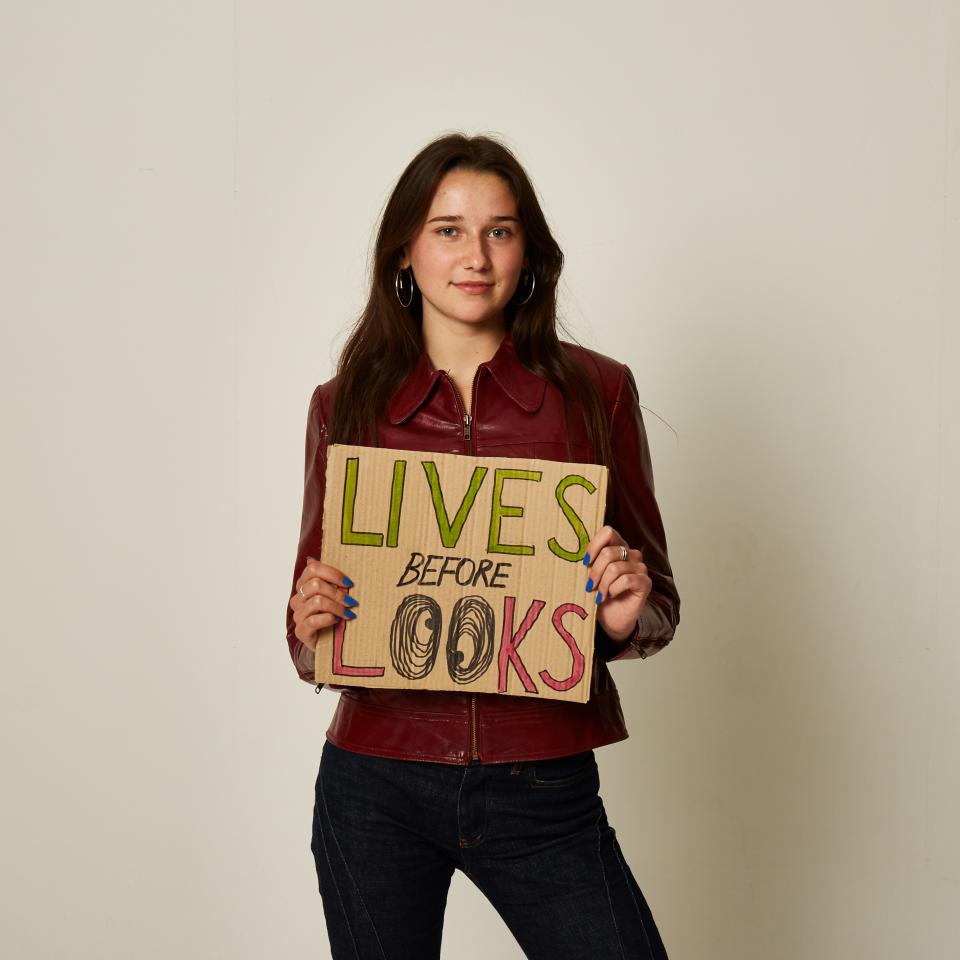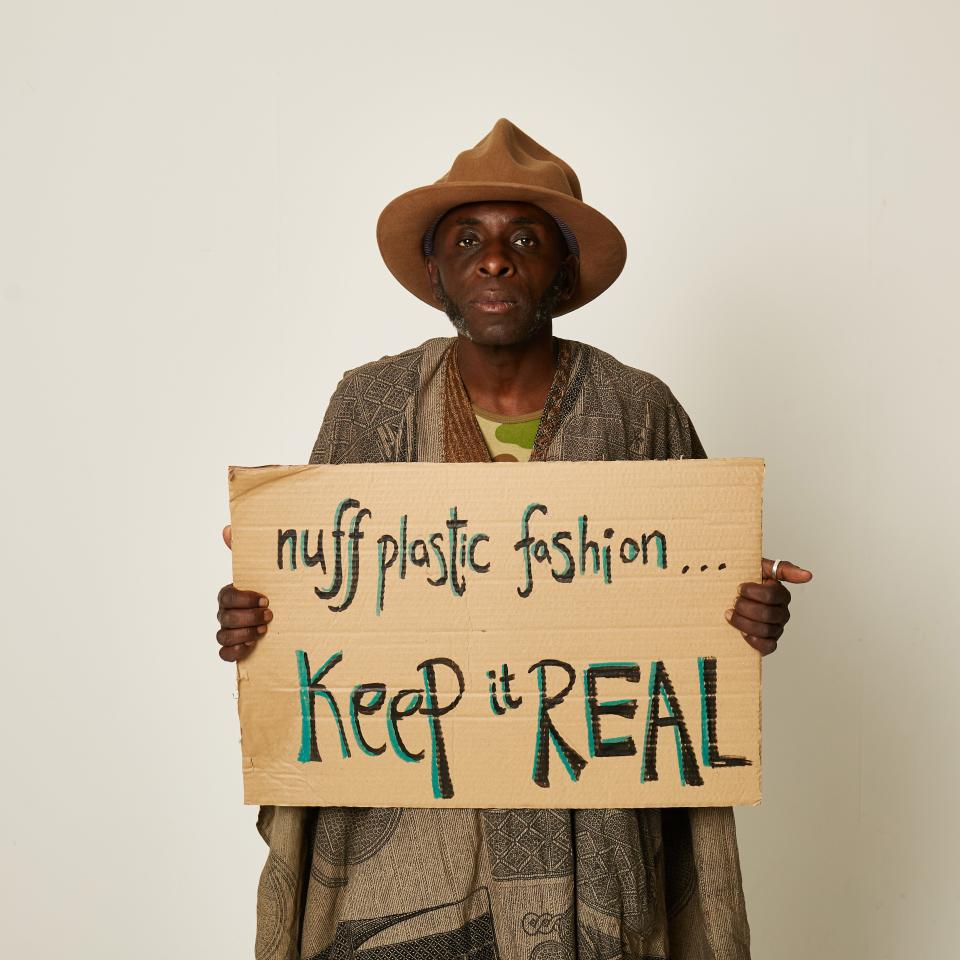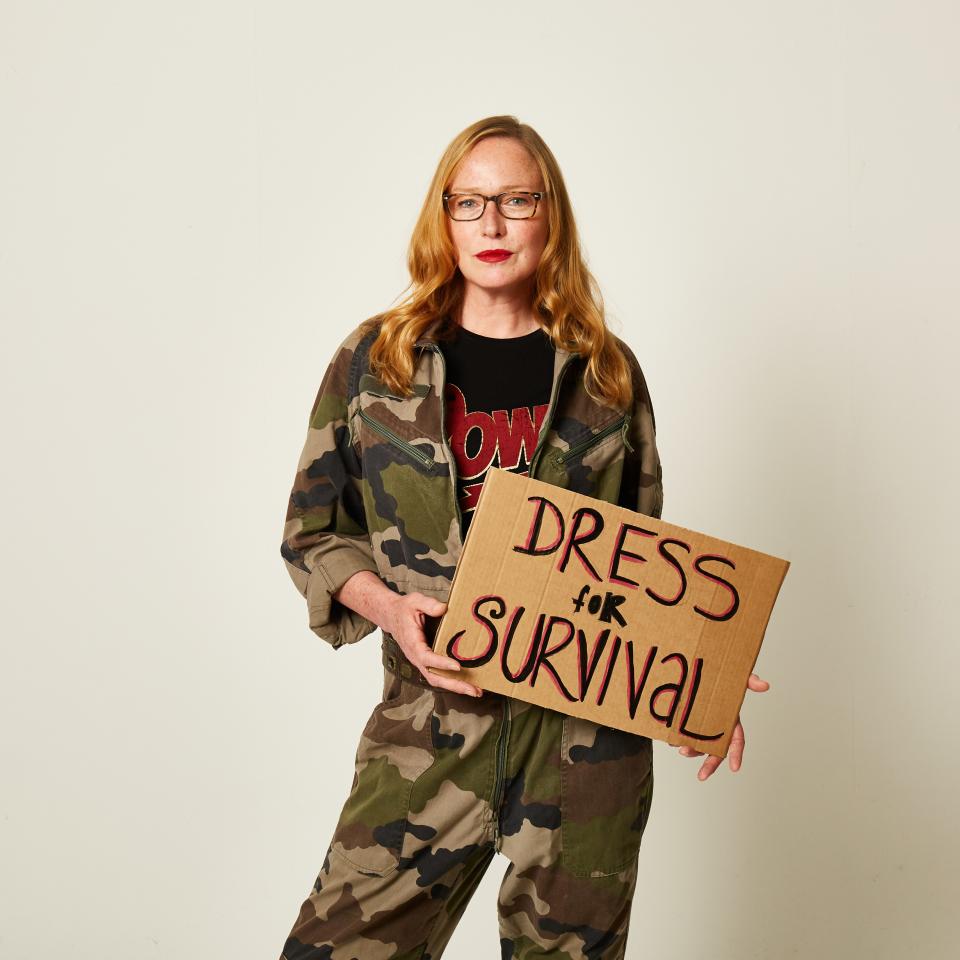Extinction Rebellion Is The Collective Calling for a Yearlong Boycott of Buying New Clothes
It’s an exciting time to be a fashion student. Across the globe, undergraduate and postgraduate students have been proudly showcasing their final collections, putting all the incredible skills and knowledge they’ve acquired throughout their studies to the test. At the beginning of June, 50 fashion master’s students at the Royal College of Art fashion program in London showed their final collections, but one student chose to go a different, slightly alternative route.
Twenty-nine-year-old Danish student Laura Karup Frandsen had been using bins to collect textile waste from the university community throughout the term, hoping to prevent the fabric from ending up in a landfill. For her final collection, she wheeled a trolley containing this waste, stuffed in more than a dozen plastic bags, into the middle of a room as models walked past. She added a white flag with the logo of Extinction Rebellion, an international movement that uses nonviolent civil disobedience for radical environmental action, which Laura had been involved with for months prior.
She also organized a “die-in” protest with members of the group to coincide with the showcase. In this “die-in,” 20 volunteers from Extinction Rebellion attended wearing all black, then dropped to the ground as if dead once the show began. Laura hoped this performance, combined with the presentation of the waste, would make the audience question “how we can still justify growing, using, and discarding resources in a time of ecological breakdown.”
After moving to London three years ago, Laura — who has always embraced an environmentally conscious attitude, which she credits to her mother and growing up in Denmark, where sustainable mind-sets are incredibly common — became increasingly shocked at the amount of waste in the city and began to investigate how she could minimize her impact as a consumer. This, she says, “very naturally” transitioned into her creative practice, especially when she noticed that her university didn’t have a recycling scheme for its textile waste, which sparked the idea for her final “collection.”

Laura’s final collection was staged in accordance with a recently launched fashion boycott campaign from Extinction Rebellion. Known for its creative protest methods, the group recently organized 10 days of climate change protests in London in April and the blockade outside the New York Times building, for more reportage on the climate emergency. It’s also staging “die-ins” in other countries as a means to spread awareness about the climate emergency, utilizing the power of social media to inspire others to take direct action, and is currently organizing multiple roadblock demonstrations across the U.K., focusing on ecological threats such as rising sea levels, floods, wildfires, crop failures, and extreme weather, as part of its “summer uprising.”
Asking the question “Is fashion really to die for?” the boycott asks people to only buy, rent, or swap recycled or upcycled items. It aims to change our relationship with clothes by encouraging us all to “take joy in making do with what we, collectively, already have.” It’s the first call to action to be announced in Extinction Rebellion’s 52 weeks of direct action campaign, and the organization hopes people will withdraw their support from all industries “that exploit people and planet for profit,” including the fashion, advertising, fossil fuel, and transport industries.
In just a few weeks, the boycott has gained serious momentum from emerging fashion designers like Phoebe English and fashion commentator Caryn Franklin. Like the School Strike for Climate movement, young people are at the center of this call for action. And Laura, who has been involved with Extinction Rebellion for months, is just one of the many faces behind the boycott as she captures and shares her commitment on social media.
“We are actually in the midst of an ecological breakdown and then at the same time allowing ourselves to use and spend so many natural resources,” Laura tells Teen Vogue. “For me, as a designer and a consumer, I could not justify that any longer.”

With a recent report by the Ellen MacArthur Foundation projecting that the fashion industry will use more than a quarter of the world’s annual carbon budget by 2050 if it continues on its current growth path, it’s hard for anyone to justify designing or purchasing new items. Currently, greenhouse gas emissions from textile production surpass those of all international flights and maritime shipping combined, and the production is projected to rise by 81% by 2030, according to the 2019 Pulse of the Fashion Industry report from the fashion industry leadership forum Global Fashion Agenda.
Malaya Loney, a 17-year-old activist based in London, cites this impact along with the treatment of garment workers in third-world countries as her own motivation for joining the boycott. Like many of Malaya’s peers, she’s been shopping mostly vintage for years due to the ’90s comeback. She doesn’t think she’ll find it too difficult to obey the rules. “If you’re thinking about taking the pledge, just do it,” she says. “It’s not about a few people doing it perfectly, but about lots of people trying to reduce their clothing consumption and waste where they can.” Her comment highlights the need for normalizing sustainable gestures in our everyday lives and the idea that although we can’t do it all, small actions do lead to big changes.
“I think we’ve realized change has got to come from us [Generation Z],” she adds — a thought she’s not alone in. Generation Z is continuously proving itself to be a generation of action, with 89% of youth believing young people can make a difference on climate change, according to the United Nations.


Globally, less than 2% of people in government are under 30 years old, but close to half a million young people are taking action on climate change through projects in their homes, schools, and communities. It’s something 24-year-old repurposed shoe designer and boycotter Lauren Amie Pariola-Birch believes was born out of dealing with climate anxiety and finding actionable solutions.
“Along with the environment, I believe this emergency has affected this generation’s physical and mental health,” Lauren tells Teen Vogue. “There is a need and desire to get grounded again and take care of ourselves, each other, and Mother Earth.”
Linda Greer, a senior scientist at NRDC with a Ph.D. in environmental toxicology, hopes this move will just become part of the “new economy” that young people are creating, expressing that this “generation is not into the purchase economy in the first place.” She believes that people are only just coming to understand the footprint the fashion industry has, from growing cotton fibers or manufacturing synthetic fibers, dyeing and finishing of the fabric, to postconsumer waste, and the “sustainable fashion” trend is currently just “nibbling around the edges” of the issue. “It really can't compensate for the impact that the industry has with manufacturing,” she says.
A complete boycott, on the other hand, is something she considers the best solution, as its impact would be directly proportional. Linda explains that if people bought 10% less clothing, this industry's carbon footprint would also go down by 10%. “For individuals, the nice way for them to think about it is, they are reducing that part of their footprint to zero by stopping to buy new things,” she says.

For 19-year-old Tolmeia Gregory, known as Tolly Dolly Posh, this incentive was enough for her to make the shift to secondhand five years ago, after a “light bulb moment” when watching the True Cost documentary. “You don’t learn about this in school, so I realized I needed to use my platform and audience as a blogger for raising awareness and inspiring positive change,” says the sustainable-fashion activist and blogger.
Tolmeia sees the fashion boycott as another opportunity to share and inspire other people rather than a challenge, as she continues to “put the planet and future” before her wardrobe and the way she expresses herself. This, however, does not stop Tolmeia from expressing herself through clothing. And she wants to encourage other fashion-conscious people to not be afraid of losing personal style when taking part. “Take it as a challenge to not only shop but to experiment with individuality,” she says. “Not shopping new and only shopping second-hand means you have to think outside the box a bit more or embrace who you really are.”

When it comes to fashion, complete boycotts offer the perfect opportunity to inspire hope through action, where the impact will be equal to the number of those involved. And while anxiety and fear about what’s to come is only natural, we recommend using it as fuel to make radical and lasting change possible in the fashion industry and beyond.
From Greta Thunberg, who’s been the leading voice in the global School Strike for Climate movement, to Jamie Margolin, the founder of the youth climate-action organization Zero Hour, to Melati Wijsen, who cofounded the youth-driven nonprofit Bye Bye Plastic Bags when she was 12, we are only just beginning to see what young people can achieve for the future of the planet — especially when they band together.
Originally Appeared on Teen Vogue

